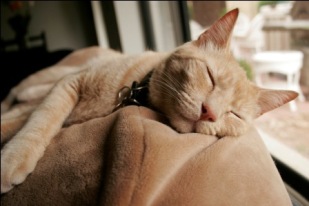 This article is the second in a 3 part series from Cat Network member Cindy Hewitt. She shares her tips for determining why your cat is not using the litter box and how to solve the problem.
This article is the second in a 3 part series from Cat Network member Cindy Hewitt. She shares her tips for determining why your cat is not using the litter box and how to solve the problem.
If your cat is not using the litter box, there is usually a reason. In my last article, I discussed reasons why the litter box is unattractive to your cat.
Other reasons cats avoid litter boxes, include medical issues and behavioral issues.
Let’s explore medical issues a cat may be experiencing if he or she is avoiding the litter box.
“Knowledge regarding feline urinary tract issues is evolving in terms of diagnostics, causes and treatments, and this can be both confusing and controversial. The current thinking is that the majority of Feline Lower Urinary Tract Disease (FLUTD) cases has no clear cause and is lumped into idiopathic cystitis or interstitial cystitis (borrowed from human medicine). Since the exact cause is unknown, the perfect therapy eludes us. To make matters worse, this syndrome of idiopathic cystitis can produce urinalysis results that sometimes yield either bacteria or crystals, obscuring the true process initially. This frustrates owners and vets alike. Often, idiopathic cystitis is finally diagnosed once a trend or repeated pattern is detected” explains Dr. Jim Dugan of Pinecrest Veterinary Hospital.
Cats frequently attempt to get our attention and let us know they are having problems by eliminating outside the litter box. When this occurs, cats should be examined by a veterinarian to insure there is no medical basis for the issue. A urinalysis should be performed to determine Ph and specific gravity, and to look for crystals, bacteria and blood in your cat’s urine. If there are no significant findings in the urinalysis, but this is a repeat or chronic issue, a radiograph should be performed. If there are still no findings, an Ultrasound is helpful in more thoroughly visualizing the bladder and bladder wall to evaluate for possible calculi. If US isn’t available, a radiograph with contrast (usually air is used to inflate the bladder) may be useful.
If a cat is going in and out of the litter box, or appears to be straining but not producing urine, it is CRITICAL to monitor carefully and if the cat cannot urinate, it is a medical EMERGENCY. A blocked urethra can be fatal and must be treated immediately. If you are unsure, segregate the cat with a clean litterbox and observe carefully to determine if it is actually urinating.
Some studies have shown that in cats under 10 years of age, the vast majority of urinary tract infections (UTI) have no bacterial component, so treatment with antibiotics may not be necessary. If there is blood in the urine, most veterinarians prescribe antibiotics to prevent infection. In addition, studies have shown that most UTIs in young cats clear in 3-5 days, with or without antibiotics, fluid therapy, both or nothing. Providing COMFORT to the cat by using medication to relieve pain and/or reduce inflammation should be discussed with your veterinarian.
Diet appears to play a role in many cases.
If the cat is producing crystals, modifying the Ph of the urine (with diet or drugs) can help prevent formation and even dissolve some existing crystals. Fluid intake also makes a difference, as larger fluid intake can help flush out any small crystals that may form. Providing a fresh flowing fountain, or giving your cat very low-sodium chicken broth (such as Pacific low sodium, free range, organic broth with about 70mg sodium/8 oz) can help increase fluid intake.
Many cats improve if fed a prescription diet such as Hill’s Rx CD Multicare, Royal Canin Urinary SO and Purina UR. If the cat improves on a prescription diet, then dietary modification is probably appropriate. If the cat improves and is stable on a prescription diet for an extended period of time, but cost is a factor, ask your vet if you can try an over-the-counter (OTC) urinary formula food such as Purina Pro Plan Urinary Formula. If your vet approves, slowly add in the OTC urinary formula food (no more than 10% at a time) over several weeks, and if the cat does well both from a digestive and urinary perspective, see if you can maintain him on the OTC urinary formula.
Additionally, if the cat has experienced painful elimination (such as with a bladder infection), it may associate this pain with the litterbox and be hesitant to use the box again. If your cat had an infection which has been successfully treated and is still hesitant to use the box, try a different type of box in a different location in an attempt to break the association.
Cat Professionals, Ltd. has produced a great booklet on FLUTD, which thoroughly outlines the diverse things that can impact your cat. It is available in print or download formats.
Thanks to Dr. Jim Dugan of Pinecrest Veterinary Hospital for contributing to this article.
In part one of this article series, Cindy shares 6 reasons why your cat may be avoiding the litter box. In part three of the series, she explains the behavioral problems that cause cats to avoid the litter box.








